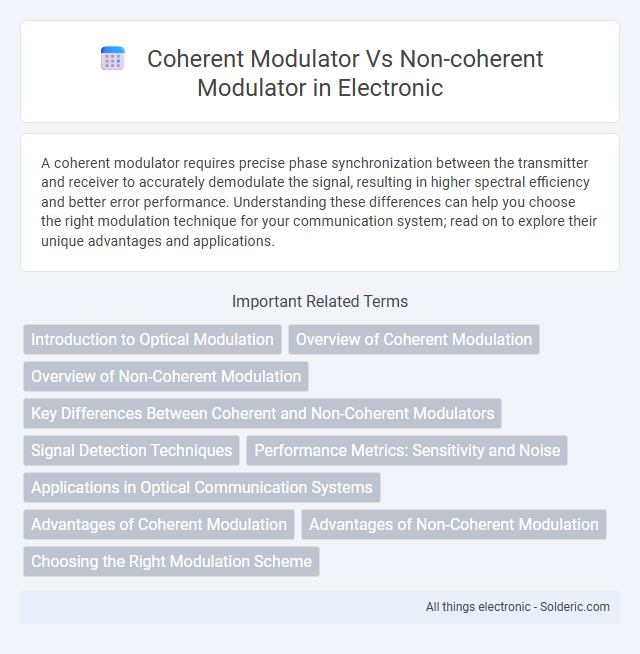A coherent modulator requires precise phase synchronization between the transmitter and receiver to accurately demodulate the signal, resulting in higher spectral efficiency and better error performance. Understanding these differences can help you choose the right modulation technique for your communication system; read on to explore their unique advantages and applications.
Comparison Table
| Feature | Coherent Modulator | Non-Coherent Modulator |
|---|---|---|
| Signal Detection | Requires phase synchronization with the carrier | No need for phase synchronization |
| Complexity | High, due to local oscillator and phase tracking | Low, simpler hardware design |
| Sensitivity | High sensitivity and better noise performance | Lower sensitivity, more susceptible to noise |
| Data Rate | Supports higher data rates effectively | Suitable for lower data rates |
| Power Efficiency | Generally less power efficient | More power efficient |
| Application | Used in high-performance communication systems (e.g., optical, radar) | Used in simpler, battery-powered, or low-cost devices |
| Error Performance | Lower bit error rate (BER) | Higher bit error rate (BER) |
Introduction to Optical Modulation
Optical modulation plays a crucial role in telecommunications by encoding information onto light signals for transmission. Coherent modulators leverage both the amplitude and phase of the light wave, offering higher spectral efficiency and improved signal quality, while non-coherent modulators rely solely on amplitude or intensity variations, simplifying design but limiting data capacity. Your choice between coherent and non-coherent modulation depends on the trade-off between system complexity and performance requirements in optical communication systems.
Overview of Coherent Modulation
Coherent modulation employs a reference carrier signal at the receiver to accurately extract both amplitude and phase information, enabling higher spectral efficiency and improved signal quality. It is essential in advanced communication systems such as QPSK, QAM, and PSK, where precise phase synchronization enhances data throughput and error performance. Coherent modulators contrast with non-coherent types by leveraging phase coherence, allowing complex constellation mapping and robust demodulation under noisy conditions.
Overview of Non-Coherent Modulation
Non-coherent modulation transmits data without requiring phase synchronization between the transmitter and receiver, enabling simpler receiver design and reduced complexity. Common non-coherent schemes include Frequency Shift Keying (FSK) and On-Off Keying (OOK), which detect frequency or amplitude variations rather than phase changes. This modulation type suits applications with limited processing power or where fast signal acquisition is critical, such as in low-power wireless communications and certain IoT devices.
Key Differences Between Coherent and Non-Coherent Modulators
Coherent modulators use a reference signal synchronized with the carrier frequency for demodulation, enabling higher sensitivity and better noise performance in data communication. Non-coherent modulators do not require phase synchronization, simplifying receiver design but generally resulting in reduced signal detection accuracy and higher error rates. Your choice between these modulation types depends on the application's need for complexity, power consumption, and error tolerance.
Signal Detection Techniques
Coherent modulators employ phase-locked detection techniques that require carrier synchronization to accurately demodulate the received signal, yielding higher sensitivity and better noise performance. Non-coherent modulators rely on energy detection methods without carrier phase information, enabling simpler receiver designs but with generally lower detection accuracy. The choice between coherent and non-coherent signal detection impacts system complexity, bit error rate, and overall communication reliability in digital modulation schemes.
Performance Metrics: Sensitivity and Noise
Coherent modulators exhibit higher sensitivity and improved noise performance by accurately preserving both amplitude and phase information, enabling better signal detection in low-power environments. Non-coherent modulators sacrifice phase information, resulting in reduced sensitivity and greater vulnerability to noise, which degrades overall system reliability. When optimizing Your communication system, choosing coherent modulation enhances signal robustness and detection accuracy under noisy conditions.
Applications in Optical Communication Systems
Coherent modulators enable higher-order modulation formats such as QPSK and QAM, providing enhanced spectral efficiency and sensitivity in long-haul and high-capacity optical communication systems. Non-coherent modulators, typically using intensity modulation with direct detection (IM-DD), are preferred in short-reach and cost-sensitive applications due to simpler receiver design and lower power consumption. Optical networks leveraging coherent modulation support advanced digital signal processing (DSP) for improved dispersion compensation and polarization multiplexing, essential for modern high-speed fiber-optic links.
Advantages of Coherent Modulation
Coherent modulation offers significant advantages over non-coherent modulation, including higher spectral efficiency and improved noise immunity, which results in better signal quality and increased data throughput. It enables accurate phase and amplitude detection by using a synchronized local oscillator at the receiver, allowing for advanced modulation schemes like QAM and PSK. Your communication system benefits from reduced error rates and enhanced performance in complex signal environments with coherent modulators.
Advantages of Non-Coherent Modulation
Non-coherent modulation offers significant advantages such as simpler receiver design and reduced signal processing complexity, allowing for cost-effective and power-efficient communication systems. It eliminates the need for carrier phase synchronization, improving performance in highly dynamic or noisy environments where phase tracking is challenging. These benefits make non-coherent modulation ideal for low data rate applications and wireless sensor networks requiring robust and reliable signal detection.
Choosing the Right Modulation Scheme
Choosing the right modulation scheme depends on factors such as signal robustness, bandwidth efficiency, and receiver complexity. Coherent modulators offer better performance in terms of bit error rate and spectral efficiency by utilizing phase information, making them suitable for high-data-rate and noise-sensitive applications. Non-coherent modulators, while simpler and more resilient to phase distortions, are preferred for low-complexity, power-efficient systems where ease of implementation outweighs spectral efficiency.
Coherent modulator vs non-coherent modulator Infographic

 solderic.com
solderic.com